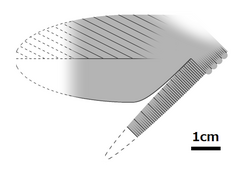Biology:Cucumericrus
| Cucumericrus | |
|---|---|

| |
| Trunk appengae of Cucumericrus decoratus | |
| Scientific classification | |
| Domain: | Eukaryota |
| Kingdom: | Animalia |
| Stem group: | Arthropoda |
| Genus: | †Cucumericrus Hou, Bergstrom & Ahlberg, 1995 |
| Type species | |
| Cucumericrus decoratus Hou, Bergstrom & Ahlberg, 1995
| |
Cucumericrus ("cucumber-leg") is an extinct genus of stem-arthropod. The type and only species is Cucumericrus decoratus, with fossils discovered from the Maotianshan Shales of Yunnan, China .[1]
Description
Cucumericrus known from a few poorly preserved specimens.[1][2] Only fragments of trunk cuticle and corresponded appendages had been revealed, while important taxonomic features such as head structures are unknown.[2][3] The trunk cuticle possess irregular wrinkles[1] and may had been soft in life.[4] Each of the trunk appendage compose of a dorsal flap-like element and a ventral stubby leg with unknown distal region,[1] structurally comparable to the trunk appendages of gill lobopodians (dorsal flaps and ventral lobopods) and euarthropod biramous appendages (flap-like exopod and limb-like endopod).[3][5] Anterior margin of the flap lined with ray-like structures, similar to the body flaps of some radiodonts. The legs have been interpreted as somewhere between annulated lobopod legs and segmented arthropod legs.[4][5]
Taxonomic affinities
Cucumericrus was originally described as a radiodont alongside Parapeytoia, a genus with somewhat similar trunk appendages, but later revealed to be a megacheiran[6][7][8][9] being misinterpreted as a leg-bearing radiodont at that time.[1] The radiodont affinity of Cucumericrus remain questionable, since the presence of legs is unknown from any other radiodonts and no other radiodont key features (e.g. frontal appendages; oral cone; head sclerites) had been discovered. Only a few phylogenetic analysis including Cucumericrus, either resolving it in a polytomy between euarthropods and other radiodonts (alongside Caryosyntrips)[10][11] or closer to euarthropods (as a basal deuteropod) than radiodonts.[12]
See also
- Caryosyntrips, another stem-arthropod with similar uncertainties.
- Parapeytoia, a megacheiran once though to be similarly leg-bearing radiodont.
- Erratus, a basal deuteropod with similar component of trunk appendages.
References
- ↑ 1.0 1.1 1.2 1.3 1.4 Xian-Guang, Hou; Bergström, Jan; Ahlberg, Per (1995-09-01). "Anomalocaris and other large animals in the lower Cambrian Chengjiang fauna of southwest China". GFF 117 (3): 163–183. doi:10.1080/11035899509546213. ISSN 1103-5897. Bibcode: 1995GFF...117..163X. https://doi.org/10.1080/11035899509546213.
- ↑ 2.0 2.1 Allison C. Daley & Graham E. Budd (2010). "New anomalocaridid appendages from the Burgess Shale, Canada". Palaeontology 53 (4): 721–738. doi:10.1111/j.1475-4983.2010.00955.x. Bibcode: 2010Palgy..53..721D. https://www.academia.edu/368049.
- ↑ 3.0 3.1 Xian-Guang, Hou; Siveter, David J.; Siveter, Derek J.; Aldridge, Richard J.; Pei-Yun, Cong; Gabbott, Sarah E.; Xiao-Ya, Ma; Purnell, Mark A. et al. (2017-04-24) (in en). The Cambrian Fossils of Chengjiang, China: The Flowering of Early Animal Life. John Wiley & Sons. ISBN 978-1-118-89638-9. https://books.google.com/books?id=2YWhDgAAQBAJ&q=Cucumericrus&pg=PA160.
- ↑ 4.0 4.1 Jan Bergström & Hou Xian-Guang (2003). "Arthropod origins". Bulletin of Geosciences 78 (4): 323–334. http://www.geology.cz/bulletin/fulltext/323_bergstrom.pdf.
- ↑ 5.0 5.1 Van Roy, Peter; Daley, Allison C.; Briggs, Derek E. G. (2015). "Anomalocaridid trunk limb homology revealed by a giant filter-feeder with paired flaps" (in en). Nature 522 (7554): 77–80. doi:10.1038/nature14256. ISSN 1476-4687. PMID 25762145. Bibcode: 2015Natur.522...77V. https://www.nature.com/articles/nature14256.
- ↑ Stein, Martin (2010). "A new arthropod from the Early Cambrian of North Greenland, with a 'great appendage'-like antennula: A NEW CAMBRIAN ARTHROPOD FROM GREENLAND" (in en). Zoological Journal of the Linnean Society 158 (3): 477–500. doi:10.1111/j.1096-3642.2009.00562.x. http://doi.wiley.com/10.1111/j.1096-3642.2009.00562.x.
- ↑ Legg, David A.; Sutton, Mark D.; Edgecombe, Gregory D.; Caron, Jean-Bernard (2012-12-07). "Cambrian bivalved arthropod reveals origin of arthrodization" (in en). Proceedings of the Royal Society B: Biological Sciences 279 (1748): 4699–4704. doi:10.1098/rspb.2012.1958. ISSN 0962-8452. PMID 23055069.
- ↑ Legg, David A.; Sutton, Mark D.; Edgecombe, Gregory D. (2013-09-30). "Arthropod fossil data increase congruence of morphological and molecular phylogenies" (in en). Nature Communications 4 (1): 2485. doi:10.1038/ncomms3485. ISSN 2041-1723. PMID 24077329. https://www.nature.com/articles/ncomms3485.
- ↑ Aria, Cédric; Zhao, Fangchen; Zeng, Han; Guo, Jin; Zhu, Maoyan (2020-01-08). "Fossils from South China redefine the ancestral euarthropod body plan". BMC Evolutionary Biology 20 (1): 4. doi:10.1186/s12862-019-1560-7. ISSN 1471-2148. PMID 31914921.
- ↑ Van Roy, Peter; Daley, Allison C.; Briggs, Derek E. G. (2015). "Anomalocaridid trunk limb homology revealed by a giant filter-feeder with paired flaps" (in en). Nature 522 (7554): 77–80. doi:10.1038/nature14256. ISSN 1476-4687. PMID 25762145. Bibcode: 2015Natur.522...77V. https://www.nature.com/articles/nature14256.
- ↑ Liu, Jianni; Lerosey-Aubril, Rudy; Steiner, Michael; Dunlop, Jason A; Shu, Degan; Paterson, John R (2018-11-01). "Origin of raptorial feeding in juvenile euarthropods revealed by a Cambrian radiodontan" (in en). National Science Review 5 (6): 863–869. doi:10.1093/nsr/nwy057. ISSN 2095-5138. https://academic.oup.com/nsr/article/5/6/863/5025873.
- ↑ McCall, Christian R. A. (2023-12-13). "A large pelagic lobopodian from the Cambrian Pioche Shale of Nevada" (in en). Journal of Paleontology 97 (5): 1009–1024. doi:10.1017/jpa.2023.63. ISSN 0022-3360. https://www.cambridge.org/core/journals/journal-of-paleontology/article/abs/large-pelagic-lobopodian-from-the-cambrian-pioche-shale-of-nevada/11B0704C49A7730AA3E8F46EB2CA1C95.
Wikidata ☰ Q5192430 entry
 |

